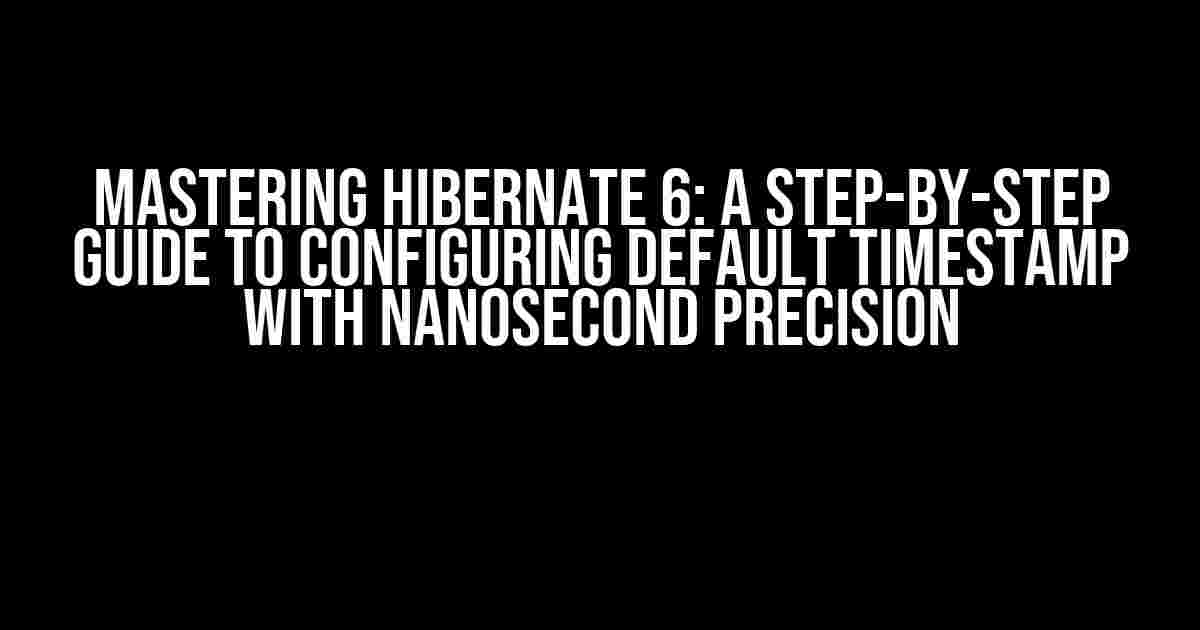Are you tired of struggling with timestamp precision in your Hibernate 6 projects? Do you want to take your database management to the next level by configuring default timestamps with nanosecond accuracy? Look no further! In this comprehensive guide, we’ll walk you through the process of configuring Hibernate 6 to use timestamps with nanosecond precision, providing you with a robust and efficient way to manage your database timestamps.
Why Do I Need Nanosecond Precision?
In today’s fast-paced world of technology, every millisecond counts. With the increasing demand for high-performance applications, precision becomes more critical than ever. Nanosecond precision in timestamps can make a significant difference in various industries, such as:
- Fraud detection and prevention
- High-frequency trading
- Real-time analytics
- IoT applications
By configuring Hibernate 6 to use nanosecond-accurate timestamps, you can:
- Improve the accuracy of time-based queries and indexing
- Enhance application performance by reducing timestamp precision errors
- Comply with industry standards and regulations that require high-precision timestamps
Configuring Hibernate 6 for Nanosecond Precision
To configure Hibernate 6 for nanosecond precision, you’ll need to follow these steps:
-
Step 1: Configure the Hibernate Dialect
-
Step 2: Update the Hibernate Configuration
-
Step 3: Define the Timestamp Type
-
Step 4: Configure the Database Column
-
Step 5: Verify the Configuration
In Hibernate 6, you can configure the dialect to use a specific database type. For this example, we’ll use the PostgreSQL95Dialect. Add the following configuration to your persistence.xml file:
<property name="hibernate.dialect" value="org.hibernate.dialect.PostgreSQL95Dialect"/>
hibernate.cfg.xml file to include the necessary configuration for nanosecond precision:
<property name="hibernate.jdbc.timestamp.precision" value="nanos"/> <property name="hibernate.temporal.resolution" value="nanos"/>
In your entity class, define the timestamp field with the correct type:
@Temporal(TemporalType.TIMESTAMP) @Column(columnDefinition = "timestamp(6) with time zone") private Timestamp createdTimestamp;
In your database, create a column with the correct type to store the nanosecond-accurate timestamp:
CREATE TABLE my_table ( id SERIAL PRIMARY KEY, created_timestamp TIMESTAMP(6) WITH TIME ZONE );
After configuring Hibernate 6, verify that the timestamp is being stored with nanosecond precision:
SELECT EXTRACT(MILLISECONDS FROM created_timestamp) AS millis,
EXTRACT(MICROSECONDS FROM created_timestamp) AS micros,
EXTRACT(NANOSECONDS FROM created_timestamp) AS nanos
FROM my_table;
Troubleshooting Common Issues
During the configuration process, you might encounter some common issues. Here are some troubleshooting tips to help you overcome them:
| Error | Solution |
|---|---|
org.hibernate.HibernateException: Unable to construct current date/time through JDBC Timestamp |
Verify that the JDBC driver version is compatible with Hibernate 6. Update the driver version if necessary. |
java.sql.SQLException: Timestamp format must be yyyy-mm-dd hh:mm:ss[.fffffffff] |
Ensure that the database column is defined with the correct timestamp type, and the Hibernate configuration is set to use the correct temporal resolution. |
org.hibernate.MappingException: Could not determine type for: java.sql.Timestamp, at table: my_table, for columns: [created_timestamp] |
Verify that the entity class is correctly annotated with the @Temporal and @Column annotations. |
Best Practices for Working with Nanosecond Precision
When working with nanosecond precision in Hibernate 6, keep the following best practices in mind:
- Use the correct database column type to store timestamps with nanosecond precision.
- Configure Hibernate to use the correct temporal resolution for timestamp fields.
- Use the
@Temporalannotation to specify the timestamp type in entity classes. - Verify that the JDBC driver version is compatible with Hibernate 6.
- Use the correct date and time formatting when inserting or updating timestamps.
By following these best practices and configuring Hibernate 6 correctly, you’ll be able to take advantage of nanosecond precision in your database management, ensuring accurate and efficient timestamp handling in your applications.
Conclusion
Configuring Hibernate 6 for nanosecond precision is a straightforward process that requires attention to detail and a solid understanding of the underlying technologies. By mastering this configuration, you’ll be able to unlock the full potential of your database management system, ensuring high-precision timestamp handling and improved application performance.
Remember, with great power comes great responsibility. Use your newfound knowledge wisely, and happy coding!
Here are 5 Questions and Answers about “How to configure Hibernate6 default for Timestamp with a nanosecond precision?”
Frequently Asked Question
Get ready to dive into the world of Hibernate6 configuration for Timestamp with nanosecond precision!
What is the default timestamp precision in Hibernate6?
In Hibernate6, the default timestamp precision is millisecond. However, with the increasing need for high-precision timestamping, it’s essential to configure Hibernate6 to support nanosecond precision.
How to configure Hibernate6 to use nanosecond precision for timestamps?
To configure Hibernate6 for nanosecond precision, you need to set the `hibernate.jdbc.time_zone` property to `’UTC’` and `hibernate.jdbc.native_sql` property to `true` in your `persistence.xml` file. Additionally, you need to use a database that supports nanosecond precision, such as PostgreSQL or Oracle.
What is the importance of setting the time zone to UTC for nanosecond precision?
Setting the time zone to UTC ensures that Hibernate6 uses a consistent and universal time zone for timestamping, which is essential for achieving nanosecond precision. UTC time zone eliminates the ambiguity of daylight saving time and ensures that timestamps are always accurate and consistent.
Can I use a different database that does not support nanosecond precision?
While Hibernate6 can be configured for nanosecond precision, it’s essential to use a database that supports this level of precision. If your database does not support nanosecond precision, you may need to consider alternative solutions, such as using a different database or implementing a custom timestamping mechanism.
Are there any performance implications of using nanosecond precision in Hibernate6?
Using nanosecond precision in Hibernate6 may have some performance implications, as it requires more precise timestamping and additional processing. However, the impact is usually minimal, and the benefits of high-precision timestamping often outweigh any performance trade-offs.


